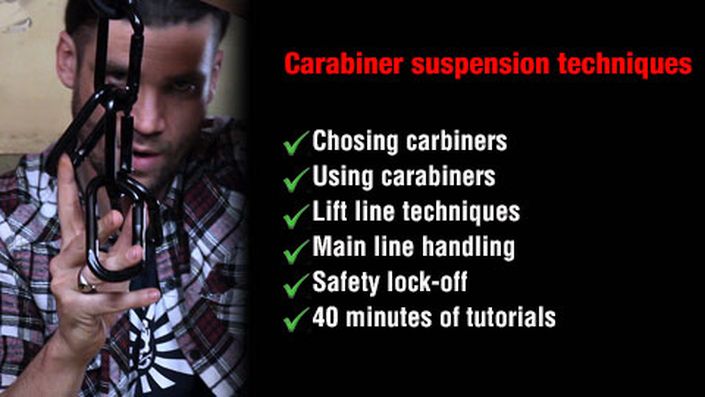
Carabiner suspension techniques
Managing suspension lines, choosing and using carabiners.
Using and choosing carabiners
This tutorial is a long overdue addition to the 'Suspension techniques' series since, so far, we have only covered the use of a ring and bamboo as these methods form the bulk of our experience. Since so many people work with carabiners, including top performers, this has been a big gap in our repertoire, even though the results of using a ring and carabiner are very similar.
As Osaka Dan, who has studied under some impressive names, typically works on carabiners, and uses them in his suspension tutorials, we felt there was no better person to demonstrate good practice. Like so many things with rope, the devil is in the detail. Watching him make this tutorial made me realise they are quite a few things I don't know about using carabiners. My excuse is that I have been using rings or bamboo for longer than I can remember. With this tutorial, none of us have an excuse for ignorance any longer.
In this tutorial, he starts by guiding you through the pros and cons of various biners before moving on to a full explanation of how to configure them for use in different suspension forms.
Choosing the right kit is important. The wrong choice of carabiner can be extremely risky as some are just not up to the job; even the wrong type of rated climbing carabiner can wreck your rope, slow you down or even cause dangerous delays in an emergency. Even if this tutorial stops you buying just one carabiner of an inappropriate type, it's paid for itself. Imagine how annoyed you'd be if you bought a whole set, only to find you'd wasted your money!
As you can see from the curriculum below, this tutorial goes beyond simply carabiners.
Line management, lifting and locking
Sound line management, lifting and locking off are all absolutely essential for safe suspensions. Your partner's life might literally depend upon these skills and, at the very least, so does your reputation. Dan guides you meticulously through rock-solid techniques, so you won't become that person who dropped their partner.
In addition to the safety considerations, proper control and technique means less effort, greater efficiency and working more smoothly. This allows you to show competence which, in turn, inspires confidence both in yourself and in your partner. You'll also improve the aesthetics of your suspensions with tidy line management.
This tutorial is not designed as a basis for suspension but to add to the techniques taught in 'Suspension techniques: Part I' or for those who are already experienced in suspension using rings or bamboo.
Your Instructor

Dan, pictured left, first discovered the art of kinbaku whilst on a working holiday in Japan in 2009. After studying under Milla Reika, __S__, and extensively under Kazami Ranki (pictured right), he moved to Toronto where he owned and operated the Toronto Kinbaku Salon.Osaka Dan teaches Kazami style shibari and is know for his bold, dynamic, erotic performance style. Osaka Dan is fascinated by deep, complex and multi layered personal exchanges that different aspects of the art can evoke.
Course Curriculum
Frequently Asked Questions
Managing subscriptions
• For your convenience, subscriptions auto-renew at the end of the period
• You can unsubscribe via Manage Subscriptions on the Profile menu (top right when logged in)
• For instructions, see Help
